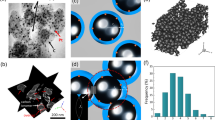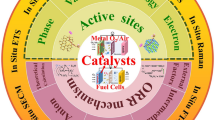Abstract
Kinetic parameters have been estimated for the H2–D2 exchange reaction on a thin film Pd catalyst by fitting reaction data from T = 333 to 593 K over a range of inlet partial pressures, \({P}_{{H}_{2}}^{in}\) and \({P}_{{D}_{2}}^{in}\). A rigorous approach to estimating the 95% confidence regions of the kinetic parameters reveals some of the issues and complexities that are not routinely considered in the estimation of kinetic parameter uncertainty from catalytic data. Three different mechanistic models were used to assess the influence of subsurface hydrogen, H′: the traditional Langmuir–Hinshelwood (LH) mechanism, the Single Subsurface Hydrogen (1H′) mechanism, and the Dual Subsurface Hydrogen (2H′) mechanism. The fitting was performed by fixing the pre-exponential factors for all Arrhenius rate constants and equilibrium constants to their transition state theory values. The diffusion of H and D atoms from the surface into the subsurface was constrained to be endothermic (i.e. \(\Delta {E}_{ss}\) > 0) and represented as an equilibrium process. Performance of the fitting routine was evaluated on a noiseless simulated dataset (created using \(\Delta {E}_{ads}^{\ddagger }\) = 0, \(\Delta {E}_{des}^{\ddagger }\) = 43, and \(\Delta {E}_{ss}\) = 25 kJ/mol) and the same simulated dataset with the inclusion of 3% Gaussian noise. In both cases, the solver was able to return the chosen values of \(\Delta {E}_{ads}^{\ddagger }\), \(\Delta {E}_{des}^{\ddagger }\), and \(\Delta {E}_{ss}\). Mapping of the behavior of the residual sum of squared errors, \({\chi }^{2}\), about its global minimum within 3D (\({\epsilon }_{ads}\), \({\epsilon }_{des}\), \({\epsilon }_{ss}\)) parameter space allowed quantification and visualization of the 95% confidence regions using 2D error ellipses for each pair of fitting parameters. For the experimental dataset on the Pd catalyst, fitting to the LH model predicted that H2–D2 exchange is adsorption rate limited, with \(\Delta {E}_{ads}^{\ddagger }\) = 51.1 ± 0.6 kJ/mol with 95% confidence. On the other hand, fitting to both the 1H′ and 2H′ models led to predictions of \(\Delta {E}_{ads}^{\ddagger }\) = 0, consistent with the current understanding that the barrier to H2 dissociation on Pd is low. Thus, the results detailed herein provide supporting evidence for a non-LH mechanism for H2–D2 exchange on Pd while also illustrating the issues associated with quantification of uncertainty in kinetic parameter estimation.
Graphical Abstract















Similar content being viewed by others
References
Strasser P, Fan Q, Devenney M, Weinberg WH, Liu P, Nørskov JK (2003) High throughput experimental and theoretical predictive screening of materials—a comparative study of search strategies for new fuel cell anode catalysts. J Phys Chem B. https://doi.org/10.1021/jp030508z
Reddington E, Sapienza A, Gurau B, Viswanathan R, Sarangapani S, Smotkin ES, Mallouk TE (1998) Combinatorial electrochemistry: a highly parallel, optical screening method for discovery of better electrocatalysts. Science. https://doi.org/10.1126/science.280.5370.1735
Smotkin ES, Jiang J, Nayar A, Liu R (2006) High-throughput screening of fuel cell electrocatalysts. Appl Surf Sci. https://doi.org/10.1016/j.apsusc.2005.08.115
Satyapal S (2015) DOE hydrogen and fuel cells program, FY2015 annual progress report. DOE Hydrog. Fuel Cells Program, FY2015 Annu. Prog. Report, Introd
Gmeiner J, Seibicke M, Behrens S, Spliethoff B, Trapp O (2016) Investigation of the hydrogenation of 5-methylfurfural by noble metal nanoparticles in a microcapillary reactor. Chemsuschem. https://doi.org/10.1002/cssc.201600045
Shevlin M, Friedfeld MR, Sheng H, Pierson NA, Hoyt JM, Campeau LC, Chirik PJ (2016) Nickel-catalyzed asymmetric alkene hydrogenation of α, β-unsaturated esters: high-throughput experimentation-enabled reaction discovery, optimization, and mechanistic elucidation. J Am Chem Soc. https://doi.org/10.1021/jacs.6b00519
Pizzi R, van Putten RJ, Brust H, Perathoner S, Centi G, van der Waal JC (2015) High-throughput screening of heterogeneous catalysts for the conversion of furfural to bio-based fuel components. Catalysts. https://doi.org/10.3390/catal5042244
Gmeiner J, Behrens S, Spliethoff B, Trapp O (2016) Ruthenium nanoparticles in high-throughput studies of chemoselective carbonyl hydrogenation reactions. ChemCatChem. https://doi.org/10.1002/cctc.201501069
Adhikari S, Fernando S (2006) Hydrogen membrane separation techniques. Ind Eng Chem Res. https://doi.org/10.1021/ie050644l
Lanning BR, Ishteiwy O, Way JD, Edlund D, Coulter K (2009) Un-Supported palladium alloy membranes for the production of hydrogen. Inorganic Membranes Energy Environ Appl. https://doi.org/10.1007/978-0-387-34526-0_11
Paglieri SN, Way JD (2002) Innovations in palladium membrane research. Sep Purif Methods. https://doi.org/10.1081/SPM-120006115
Hammer B, Norskov JK (1995) Why gold is the noblest of all the metals. Nature. https://doi.org/10.1038/376238a0
Aasberg-Petersen K, Nielsen CS, Lægsgaard Jørgensen S (1998) Membrane reforming for hydrogen. Catal Today. https://doi.org/10.1016/S0920-5861(98)00341-1
deRosset AJ (1960) Diffusion of hydrogen through palladium membranes. Ind Eng Chem. https://doi.org/10.1021/ie50606a035
Sinfelt JH, Catal CJ, Catal, AE (1987) Bimetallic catalysts: discoveries, concepts, and applications
Wei T, Wang J, Goodman DW (2007) Characterization and chemical properties of Pd-Au alloy surfaces. J Phys Chem C. https://doi.org/10.1021/jp067177l
Lewis FA (1995) The palladium-hydrogen system: structures near phase transition and critical points. Int J Hydrogen Energy. https://doi.org/10.1016/0360-3199(94)00113-E
Jayaraman V, Lin YS (1995) Synthesis and hydrogen permeation properties of ultrathin palladium-silver alloy membranes. J Memb Sci. https://doi.org/10.1016/0376-7388(95)00040-J
Shu J, Grandjean BPA, Neste A, Van Kaliaguine S (1991) Catalytic palladium-based membrane reactors: a review. Can J Chem Eng. https://doi.org/10.1002/cjce.5450690503
Rogers HC (1968) Hydrogen embrittlement of metals: atomic hydrogen from a variety of sources reduces the ductility of many metals. Science. https://doi.org/10.1126/science.159.3819.1057
OBrien CP, Miller JB, Morreale BD, Gellman AJ (2011) The kinetics of H 2-D 2 exchange over Pd, Cu, and PdCu surfaces. J Phys Chem. https://doi.org/10.1021/jp2076885
O’Brien CP, Miller JB, Morreale BD, Gellman AJ (2012) H2–D2 exchange kinetics in the presence of H2S over Pd4S, Pd70Cu30, and Pd47Cu53 surfaces. J Phys Chem C. https://doi.org/10.1021/jp305024b
Lewis FA (1982) Palladium-hydrogen system - 2. Platin Met Rev
Uemiya S, Matsuda T, Kikuchi E (1991) Hydrogen permeable palladium-silver alloy membrane supported on porous ceramics. J Memb Sci. https://doi.org/10.1016/S0376-7388(00)83041-0
Hurlbert RC, Konecny JO (1961) Diffusion of hydrogen through palladium. J Chem Phys. https://doi.org/10.1063/1.1701003
Jewett DN, Makrides AC (1965) Diffusion of hydrogen through palladium and palladium-silver alloys. Trans Faraday Soc. https://doi.org/10.1039/tf9656100932
Pyun S, Lee WT, Yang TH (1997) Hydrogen diffusion through palladium-gold alloy coatings electrodeposited on palladium substrate under permeable boundary condition. Thin Solid Films. https://doi.org/10.1016/S0040-6090(97)00458-6
Conrad H, Ertl G, Latta EE (1974) Adsorption of hydrogen on palladium single crystal surfaces. Surf Sci. https://doi.org/10.1016/0039-6028(74)90060-0
Ferrin P, Kandoi S, Nilekar AU, Mavrikakis M (2012) Hydrogen adsorption, absorption and diffusion on and in transition metal surfaces: a DFT study. Surf Sci. https://doi.org/10.1016/j.susc.2011.12.017
Herron JA, Tonelli S, Mavrikakis M (2012) Atomic and molecular adsorption on Pd(111). Surf Sci. https://doi.org/10.1016/j.susc.2012.07.003
Ludwig W, Savara A, Madix RJ, Schauermann S, Freund HJ (2012) Subsurface hydrogen diffusion into Pd nanoparticles: role of low-coordinated surface sites and facilitation by carbon. J Phys Chem C. https://doi.org/10.1021/jp209033s
Savara A, Ludwig W, Schauermann S (2013) Kinetic evidence for a non-langmuir-hinshelwood surface reaction: H/D exchange over Pd nanoparticles and Pd(111). ChemPhysChem. https://doi.org/10.1002/cphc.201300179
Sen I, Gellman AJ (2018) Kinetic fingerprints of catalysis by subsurface hydrogen. ACS Catal. https://doi.org/10.1021/acscatal.8b02168
Teschner D, Borsodi J, Wootsch A, Révay Z, Hävecker M, Knop-Gericke A, Jackson SD, Schlögl R (2008) The roles of subsurface carbon and hydrogen in palladium-catalyzed alkyne hydrogenation. Science. https://doi.org/10.1126/science.1155200
Khan NA, Shaikhutdinov S, Freund HJ (2006) Acetylene and ethylene hydrogenation on alumina supported Pd-Ag model catalysts. Catal Lett. https://doi.org/10.1007/s10562-006-0041-y
Greeley J, Mavrikakis M (2005) Surface and subsurface hydrogen: adsorption properties on transition metals and near-surface alloys. J Phys Chem B. https://doi.org/10.1021/jp046540q
Mei D, Neurock M, Smith CM (2009) Hydrogenation of acetylene-ethylene mixtures over Pd and Pd-Ag alloys: first-principles-based kinetic monte carlo simulations. J Catal. https://doi.org/10.1016/j.jcat.2009.09.004
Studt F, Abild-Pedersen F, Bligaard T, Sørensen RZ, Christensen CH, Nørskov JK (2008) On the role of surface modifications of palladium catalysts in the selective hydrogenation of acetylene. Angew Chemie - Int Ed. https://doi.org/10.1002/anie.200802844
Christmann K (1988) Interaction of hydrogen with solid surfaces. Surf Sci Rep. https://doi.org/10.1016/0167-5729(88)90009-X
Kondratyuk P, Gumuslu G, Shukla S, Miller JB, Morreale BD, Gellman AJ (2013) A microreactor array for spatially resolved measurement of catalytic activity for high-throughput catalysis science. J Catal. https://doi.org/10.1016/j.jcat.2012.12.015
Fleutot B, Miller JB, Gellman AJ (2012) Apparatus for deposition of composition spread alloy films: the rotatable shadow mask. J Vac Sci Technol A Vacuum Surfaces Film. https://doi.org/10.1116/1.4766194
Catalytic Reaction Engineering. Stud Surf Sci Catal 1993 79(C): 251–306. https://doi.org/10.1016/S0167-2991(08)63811-2.
Dumesic JA (1993) The microkinetics of heterogeneous catalysis. ACS Prof Ref B
Wang B, Shi W, Miao Z (2015) Confidence analysis of standard deviational ellipse and its extension into higher dimensional euclidean space. PLoS ONE. https://doi.org/10.1371/journal.pone.0118537
Behm RJ, Christmann K, Ertl G (1980) Adsorption of hydrogen on Pd(100). Surf Sci 99(2):320–340. https://doi.org/10.1016/0039-6028(80)90396-9
Acknowledgements
The authors would like to acknowledge financial support for this work from the National Science Foundation through grant number CHE1954340.
Author information
Authors and Affiliations
Corresponding author
Ethics declarations
Conflicts of interest
The authors have no conflict of interest.
Additional information
Publisher's Note
Springer Nature remains neutral with regard to jurisdictional claims in published maps and institutional affiliations.
Rights and permissions
About this article
Cite this article
Golio, N., Sen, I., Guo, Z. et al. Kinetic Parameter Estimation for Catalytic H2–D2 Exchange on Pd. Catal Lett 153, 1–18 (2023). https://doi.org/10.1007/s10562-022-03961-0
Received:
Accepted:
Published:
Issue Date:
DOI: https://doi.org/10.1007/s10562-022-03961-0




